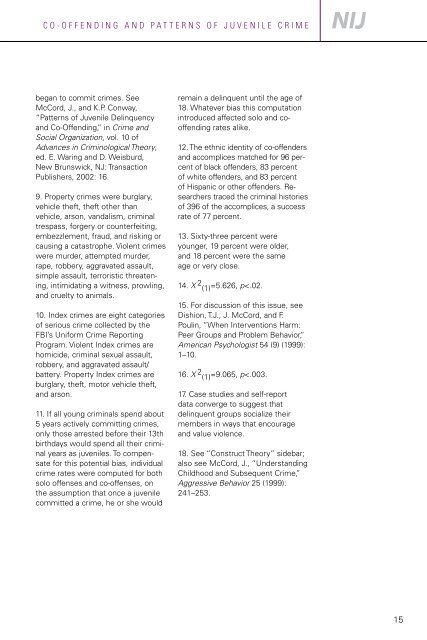Co-Offending and Patterns of Juvenile Crime - justice studies
Co-Offending and Patterns of Juvenile Crime - justice studies
Co-Offending and Patterns of Juvenile Crime - justice studies
Create successful ePaper yourself
Turn your PDF publications into a flip-book with our unique Google optimized e-Paper software.
C O - O F F E N D I N G A N D P A T T E R N S O F J U V E N I L E C R I M E<br />
began to commit crimes. See<br />
Mc<strong>Co</strong>rd, J., <strong>and</strong> K.P. <strong>Co</strong>nway,<br />
“<strong>Patterns</strong> <strong>of</strong> <strong>Juvenile</strong> Delinquency<br />
<strong>and</strong> <strong>Co</strong>-<strong>Offending</strong>,” in <strong>Crime</strong> <strong>and</strong><br />
Social Organization, vol. 10 <strong>of</strong><br />
Advances in Criminological Theory,<br />
ed. E. Waring <strong>and</strong> D. Weisburd,<br />
New Brunswick, NJ: Transaction<br />
Publishers, 2002: 16.<br />
9. Property crimes were burglary,<br />
vehicle theft, theft other than<br />
vehicle, arson, v<strong>and</strong>alism, criminal<br />
trespass, forgery or counterfeiting,<br />
embezzlement, fraud, <strong>and</strong> risking or<br />
causing a catastrophe. Violent crimes<br />
were murder, attempted murder,<br />
rape, robbery, aggravated assault,<br />
simple assault, terroristic threatening,<br />
intimidating a witness, prowling,<br />
<strong>and</strong> cruelty to animals.<br />
10. Index crimes are eight categories<br />
<strong>of</strong> serious crime collected by the<br />
FBI’s Uniform <strong>Crime</strong> Reporting<br />
Program. Violent Index crimes are<br />
homicide, criminal sexual assault,<br />
robbery, <strong>and</strong> aggravated assault/<br />
battery. Property Index crimes are<br />
burglary, theft, motor vehicle theft,<br />
<strong>and</strong> arson.<br />
11. If all young criminals spend about<br />
5 years actively committing crimes,<br />
only those arrested before their 13th<br />
birthdays would spend all their criminal<br />
years as juveniles. To compensate<br />
for this potential bias, individual<br />
crime rates were computed for both<br />
solo <strong>of</strong>fenses <strong>and</strong> co-<strong>of</strong>fenses, on<br />
the assumption that once a juvenile<br />
committed a crime, he or she would<br />
remain a delinquent until the age <strong>of</strong><br />
18. Whatever bias this computation<br />
introduced affected solo <strong>and</strong> co<strong>of</strong>fending<br />
rates alike.<br />
12. The ethnic identity <strong>of</strong> co-<strong>of</strong>fenders<br />
<strong>and</strong> accomplices matched for 96 percent<br />
<strong>of</strong> black <strong>of</strong>fenders, 83 percent<br />
<strong>of</strong> white <strong>of</strong>fenders, <strong>and</strong> 83 percent<br />
<strong>of</strong> Hispanic or other <strong>of</strong>fenders. Researchers<br />
traced the criminal histories<br />
<strong>of</strong> 396 <strong>of</strong> the accomplices, a success<br />
rate <strong>of</strong> 77 percent.<br />
13. Sixty-three percent were<br />
younger, 19 percent were older,<br />
<strong>and</strong> 18 percent were the same<br />
age or very close.<br />
14. X 2 (1) =5.626, p





